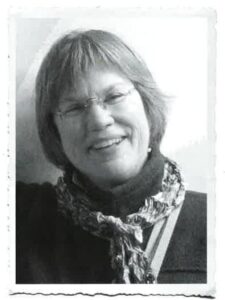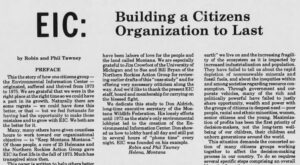By Katy Spence

In the late ’60s and early ’70s, Montana’s environment didn’t have much representation in legislative processes, aside from the dogged efforts of Don Aldrich, a Montana Power employee-turned-avid-conservation-lobbyist and executive secretary of the Montana Wildlife Federation.
In 1971, Don asked two young college students to join him at the legislative session: Phil and Robin Tawney. The “Environmental Lobby” – as they dubbed themselves – rallied grassroots support and pushed legislators. In the process, Don, Phil, Robin, and others realized Montana needed a year-round, statewide organization to address persistent challenges to the state’s air, water, and land. Hence, the Environmental Information Center (EIC) was founded in 1973 with the help of many friends, conservationists, and community members from around the state.
I chatted with Robin about the early days, Montana’s new (and old) challenges, and what we both hope to see next. This conversation has been edited for clarity and readability.
Katy Spence (KS): Can you share more about what led to the creation of EIC?
Robin Tawney Nichols (RTN): Soon after the first Earth Day, Don Aldrich came to Philip and me and asked us to join him at the 1973 legislative session. We rented a little house a block from the Capitol, and the three of us brought a bunch of elk meat and hunkered down. Don was a wonderful man. He was such a mentor. [But] about midway through the session, he said, “Okay, I’m going home.” Before we joined Don, he had carried the load solo for at least two sessions, and you know how it is – tensions were high, and the work was stressful. He had built a fabulous phone network, talking to people all over the state, especially those in the affiliates of the Wildlife Federation. He left that phone net and the lobbying to us. Baptism by fire. When the ’73 session ended, and we realized there was going to be, you know, that one anomaly of annual sessions – ’74 and ’75 – and we realized that there had to be a presence. We saw a need for a statewide organization, a new one that could incorporate a lot of people from all over. One thing led to another, and we formed an organization.
KS: Could you imagine in 1973 that you might be sitting with someone in 2023 talking about this organization you just started?
RTN: We built it to last, but we never thought about 50 years ahead. The reason we built it to last was that we wanted staff to be able to live comfortably and lead “normal” lives with families if they so choose. We wanted MEIC to be sustainable.
 This article appeared in the 1977 version of the NRAG Papers, available on MEIC’s website.
This article appeared in the 1977 version of the NRAG Papers, available on MEIC’s website.
KS: What were some of the environmental challenges Montana was facing in the 1970s and how do they compare to the challenges today?
RTN: I think it’s amazing how much they’ve stayed the same. Just when you think that something’s dead, it’s not. Challenges take different forms, and they show that there needs to be an organization like MEIC that’s vigilant, to stay on top of them, because we can’t ignore them.
KS: What are some of the continuing battles that you’ve noticed?
RTN: One is energy. In ’73, the energy crisis precipitated all sorts of [issues]. We’re still trying to get renewables. It’s gotten better, but it hasn’t gotten to where we need to go. And the conservation of energy piece is always left out. Always. And then we thought we’d solved hardrock mining. Subdivision development was a big deal, a big hairy deal. The state had no idea what was going on. None. Zip. They had the nubbins of a planning department, but they had no idea. So [EIC] did a comprehensive research project.
KS: The 1975 Subdivision Inventory Project?
RTN: That’s right. That was Christine Torgrimson, who also started Down to Earth. I started “Capitol Monitor.”
KS: Those are two of my favorite publications to work on at MEIC, and Ann Schwend is hoping to update the 1975 Subdivision Inventory Project. Looking back, what are you most proud to see come out of MEIC?
RTN: For me, MEIC is fulfilling the vital role we envisioned as a year-round watchdog and advocate for sound environmental legislation and policy that reflect our state constitution, while providing a living for the people who work for it. Yeah, that’s kind of what I’m most proud of.
KS: I’m very proud to work for an organization with such an important impact and that I get to work with some of the smartest, most competent, and funniest people I know. Where would you like to see the organization go next?
RTN: I would say keep on keeping on. And listen. Listen to people. Try to sort through the noise to hear people. Everybody is of value. When you think about where we are socially, realize that people need food on the table and adequate housing before there’s any room to think about anything else. Those social needs are so important. [I hope] the MEIC staff, board, and members are involved in other things outside of MEIC where they’re working side-by-side with people from different perspectives. Get to know people outside your social circle and you learn to respect each other. By building mutual trust, you might change some minds. Or not. The important thing is creating space for dialogue. That’s a big deal – having respect and valuing people.
KS: That sounds a lot like the direction we’re trying to move – working with diverse communities, listening, and working to help address the full needs of people.
RTN: That’s great.
KS: Do you have anything else to add?
RTN: Cheers!
Robin and her late husband Phil received the American Motors Conservation Award in 1976 and MEIC’s Conservationist of the Year Award in 1995. Both received the Missoula Conservation Roundtable’s Don Aldrich Fish, Wildlife and Conservation Award (Phil in 1989, Robin in 2000), and together were inducted into the Montana Outdoor Hall of Fame in 2018. Robin recently retired from the board of the Cinnabar Foundation after serving 28 years as a board member and 24 as board president. Robin has authored several books and her byline has appeared in many publications across the country. She currently lives in Missoula with her husband William Nichols.
This article was published in the September 2023 issue of Down To Earth.

